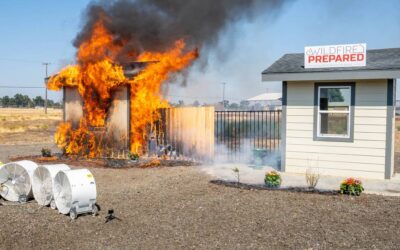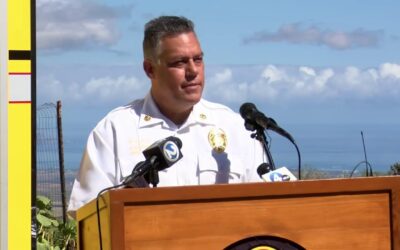Preplanning for your community’s needs

Assess the community’s needs with a gap analysis to improve the larger picture by having each member be the steward of the town. (Photo by author.)
SETH BARKER | From the March 2016 Issue of FireRescue Magazine
Community is defined as a group of people living in the same place or having a particular characteristic in common. It is safe to say that most of us in the fire service think of our community as a motivating factor for what drives us to get out of bed to go to work. We serve our community, we protect it, we cherish it, and above all else we want to belong to it. Doesn’t it make sense to enable the very place we swore to help become a better place? After his probationary period was up, one of my rookie firefighters told me: “Leave it better than when you found it, Cap.†These words hit me hard and drive me every day I put on the badge. What can we do better? How can we be better? What would make us better?
Internalizing these questions is a topic within itself. I believe that everyone reporting for work in any capacity within the fire service is always asking these questions. No member gets out of bed, choosing to put the community before friends, family, and loved ones, to go the job thinking, “I am really going to do the worst possible job I can today.†One of the reasons the fire service is so unique is that everyone wants to be the best at what they do. Understanding that everyone’s intentions are usually good, it is the interpretation of those intentions that we need to have a better grip on.
When we meet other members on the job, we have to be patient in recognizing this trait. Taking it to the community level, more patience is required. The community’s members would never start the day off thinking, “I am really going to make the Hometown Fire Department feel bad today†(although you might feel there are just one or two). Everyone wants to be better. It would be very simplistic to believe that we can just measure all of our shortcomings and fix them immediately; this type of thinking is farfetched, to say the least. We need help. On a personal, social, and professional level, very few people are wired to accommodate immediate change. It is an evolution through experience and hard work.
Managing the Critics
How can we be better? How can we leave it better than we found it? These are still hard questions. The answer that lies in front is more training-more realistic training. As my good friend Chief Forest Reeder says, make it more “realistic, relevant, and verifiable.†Have the troops be part of the process. If gaps are found, then brainstorm ways to fill them. Be part of the solution, not a critic on the sideline. Too often it is the critics who drag the process down by stalling it with negative feedback that is unproductive. Much like someone at the public meeting who criticizes the spending on a new apparatus … wait a minute!
Isn’t that the same type of behavior we often see with disgruntled customers? They are quick to lash out at something that they don’t understand. What entities in the community spend money, drive around in highly visible vehicles, and are constantly in the public eye? Police officers? Firefighters? City officials? Members of the board of trustees? These are all very easy targets for the uneducated to criticize. I remember when I was upset with a school board and thought I could save the world by running for a position. I called my brother (a 22-year school teacher in a different state) and told him that I was running. He asked if I was upset about something the school district was doing. I responded with an expletive and an affirmation. He told me to get educated. Learn everything there is to know about the school, the district, its employees, its union, its land, and its funding. Then, if I was still thinking that my issue was the most important, I should absolutely run for the position and bask in my own glory. Well, there were much larger issues that made my “criticism†very small and meaningless. It was another powerful lesson learned. So, how can we bring this around full circle?
When a junior firefighter walks through the captain’s office door and says, “Cap, we need new thermal imaging cameras (TICs) because ours are older than dirt,†we don’t immediately say, “OK, kid, go forth and spend $30,000 on new TICs.†We suggest doing research and cost analysis and looking at practicality, budget constraints, and overall priorities. We ask them to come back with a detailed plan to answer all of these questions.
Working with the Community
So, when the community is up in arms about spending, response profiling, staffing, and operational proficiency, we answer with education. We answer with training. We answer with effective communication. We answer with getting everyone involved. We incorporate the community into the decision-making and problem-solving process. We make it an absolute priority to embrace the community’s concerns as our concerns. We demand complete satisfaction from the customer on every level. Have the community be the voice. It does not matter what voice or from which aspect. Having them “own†the voice is the most important piece. Allow the stakeholders in the community to be our champions so it is their voice that is heard. Everyone shares these problems so we can all share in the successes and failures together. This is a concept that is very difficult to accomplish but again has a very realistic and simplistic answer.
How do we accomplish this communication? We do so through training and education and by offering good sound advice with public awareness so everyone starts singing to the same tune. We can start by assessing our major target hazards within our community and bringing them to the forefront of the conversation. Most fire districts that lie in the shadow of a major wildland-urban interface threat have this concept weighing heavily on their minds. How can we possibly educate everyone to be on the same page?
Let’s look at the dynamic in the firehouse first. We can’t possibly rely on one single training officer to deliver a new training concept to the troops. We need to rely on our company officers to institute a positive culture of training and communication. With sound buy-in on the company level, the message is far more powerful. We can use this same strategy with public education. Target the stakeholders, businesses, city officials, homeowner associations, and professional groups around the community to provide them with accurate information to spread.
For example, having neighbors policing neighbors on safe wildland fuel mitigation techniques to create community continuity is tremendously effective. Not only is it education through our peers (which is exponentially more powerful), but it saves us time and resources through effective communication. If entire tracts, roads, subdivisions, and developments are instituting real guidelines on effective landscaping techniques to promote safe and defendable homes, then our job becomes a lot safer. Sharing the problem as a community lets everyone have ownership of it.
Shared Purpose
Sharing the community’s issues and recognizing everyone’s needs are equally important. We must all help each other in times of need. When the fire department needs more staffing, empower the community to look at all of the options. Through education and training, ensure that each voice is heard and addressed. Share support across the community and recognize it’s not just about the fire department, the school, the parks, or public works-it’s about the whole picture. So when it is the educations department’s turn for a new elementary school, the entire community, which has been supporting the last endeavor, rallies for the kids.
Assess the community’s needs with a gap analysis to improve the larger picture by having each member be the steward of the town. Combine full transparency with education and training. Help each other understand the threats and problems we are all facing as a community. Have each customer’s voice heard. Listen not to the voice of the fire department but to the voice of the community. This is much more powerful than fire department personnel complaining that their needs are the most important.
Community is a group of people living in the same place or having a particular characteristic in common. Join with those you live and work with so you leave your community better than you found it.
 Seth Barker is a captain and training officer for the Big Sky (MT) Fire Department. He is a state fire instructor for the Montana State Fire Service Training School and a state lead EMS instructor. Barker has a Blue Card Instructor certification, is an ISFSI instructor, and is one of the curators for FirefighterCloseCalls.com
Seth Barker is a captain and training officer for the Big Sky (MT) Fire Department. He is a state fire instructor for the Montana State Fire Service Training School and a state lead EMS instructor. Barker has a Blue Card Instructor certification, is an ISFSI instructor, and is one of the curators for FirefighterCloseCalls.com




